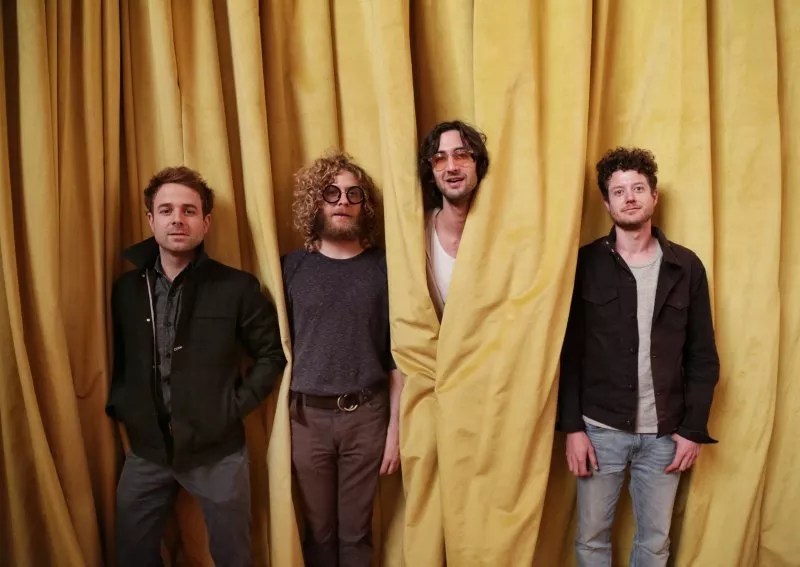
Courtesy Dawes

Audio By Carbonatix
Rock stars don’t often name-drop such authors as Thomas Pynchon, David Foster Wallace and William Gaddis when they talk about their rock-and-roll influences, but Dawes lead singer and guitarist Taylor Goldsmith specifically credits those three scribes for helping shape his music-writing perspective while the band put together its latest album, Misadventures of Doomscroller (2022, Rounder Records).
In a sonic shift, the idea that more is more – whether in books or in music – resulted in a “maximalist” approach to songwriting for the L.A. indie rockers. Of course, other musicians have explored such a concept before, including Miles Davis and Frank Zappa, Goldsmith shares.
“I just feel like as an artist, as a writer, as a creator of some kind, you’re kind of taught this idea that you always got to be cutting and cutting and being as economical as possible. That’s what people want. It’s sort of stated like a law,” he adds. “Then with reading their books, I started to realize that that’s not true. You don’t always have to be economical. You don’t have to always get it down to what is absolutely essential. I love that way of making art, but I also like a fifteen-minute Miles Davis self-indulgent song. … I like when Frank Zappa has, like, fifty sections in one thing and it’s all through-composed, and I like those books.”
With Misadventures of Doomscroller, Goldsmith allowed himself to be a little “uncomfortable” and let loose on guitar more so than he usually does. Bandmates Griffin Goldsmith (drums), Wylie Gelber (bass) and Lee Pardini (keyboards) followed suit. The result is an easy-listening, funky, smooth-rock record that includes moments of extended jamming and showcases the quartet’s musicianship more so than previous Dawes albums. For comparison’s sake, Dawes has the ability to dive into a mellow yacht-rock melody reminiscent of Hall & Oates, only to follow it up with a Southern-rock solo that sounds like a long-lost Lynyrd Skynyrd deep cut.
“For me, I always come from the school of thought that I don’t want to get too flashy with the progression unless it really needs a certain color emotionally. I don’t want to have any extra verses that don’t need to be there,” Goldsmith says, adding that he gave himself “permission” to go bigger, to allow his guitar playing to be more prominent throughout songs.
“I just feel like making stuff is a quest to get yourself as hyped as you were the first time you made something. I can keep going back to writing mid-tempo, acoustic-y, five-minute songs with here-comes-the-chorus kind of stuff,” he continues. “I’m proud of that, and I like listening to it; I know how to do it. But I also feel like I need to get to a place where I’m uncomfortable and in the position where I’m doing something where I’m not sure I know how to do it.”
That translated to the recording studio as well, where Dawes would run through the new tunes more than usual in an attempt to get each part of each song just right.
“We would finish a take and be like, ‘I’m pretty sure the outro was solid, but I don’t remember what the first part was like. It was a long time ago,'” Goldsmith says. “Then a half-hour goes by, and it’s another full ten minutes to play the song, so by the time we would do three takes of the song, we were running out of daylight.”
He calls that type of process “unique” for the band, even though he admits there was some trepidation whenever they began to lay down tracks together. But that’s the discomfort he was talking about.
“I loved that feeling, because I didn’t know if we had that in our fingers. In the past when I’ve recorded songs like ‘Crack the Case’ or ‘Between the Zero and the One,’ which I’m very proud of, I knew when I sat down that I know how to do this – whereas nothing on this record gave me that feeling.”
Bigger songs have made for longer set lists, too, as Dawes is currently offering more of an “evening with” format that includes two full sets during the current tour. The group will be at the Ogden Theatre Wednesday, April 19.
“It’s a thrill for us because it keeps us familiar with the whole body of work, and I think that’s actually a pretty rare gift that musicians have,” Goldsmith says. “It’s not like novelists and filmmakers get to go play with the stuff that they made through the years, but musicians do get to do that.”
As much time and thought and energy that went into writing and recording Misadventures of Doomscroller, Dawes doesn’t necessarily have a strict pre-tour practice schedule.
“It’s weird, but we don’t even really rehearse for tour. We just kind of hit the ground running, because that’s when we’re at our best,” Goldsmith says. “When we’re a little bit on edge as to how something’s going, there’s a lot more eye contact, there’s a lot more connection. It’s loose, but in a way that I’m really proud of and really speaks to how locked into something that we all are together.”
Dawes, 8 p.m. Wednesday, April 19, Ogden Theatre, 935 East Colfax Avenue. Tickets are $36-$45.